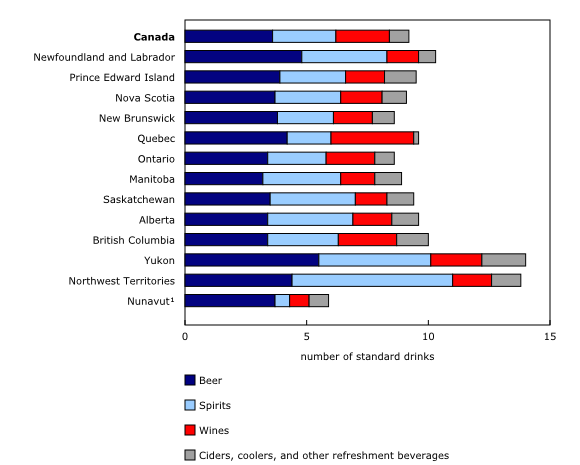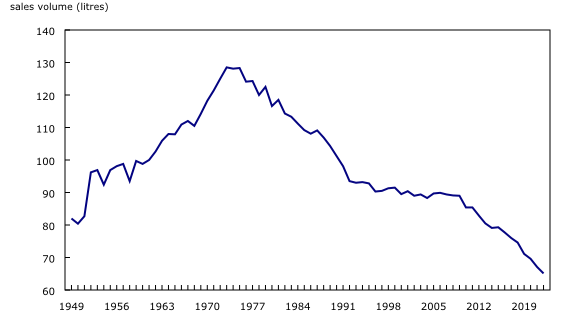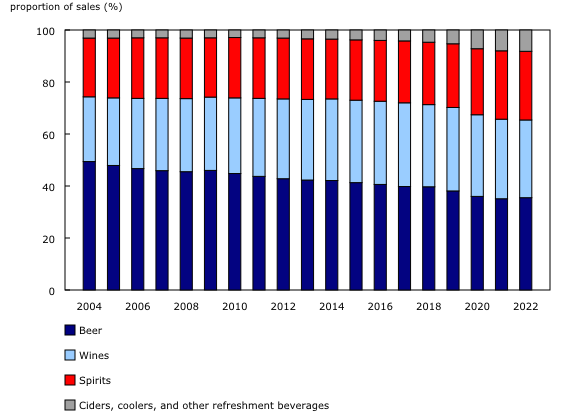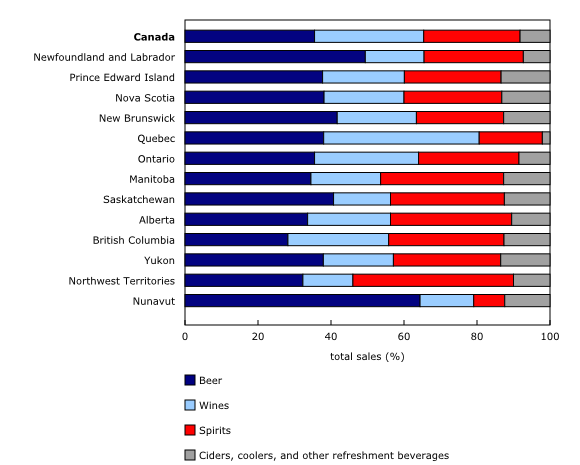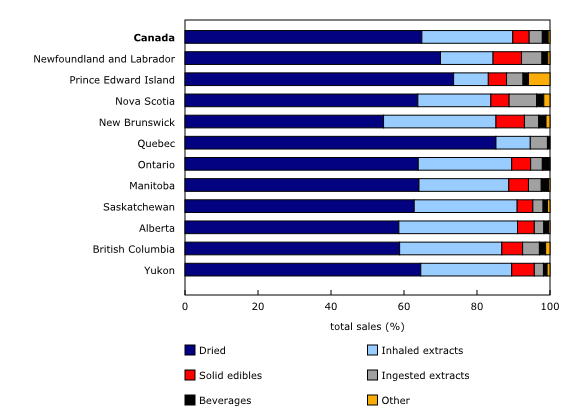Control and sale of alcoholic beverages and cannabis, April 1, 2022, to March 31, 2023
Released: 2024-03-06
Government revenue from alcohol and cannabis totals $15.5 billion
Federal and provincial governments earned $15.5 billion (+2.5%) from the control and sale of alcohol ($13.6 billion, +0.1%) and recreational cannabis ($1.9 billion, +24.2%) in the fiscal year ending March 31, 2023. This includes net income from provincial liquor and cannabis authorities, excise taxes, retail sales taxes, other specific taxes, and licenses and permits.
Inflation drives alcohol sales increase; volumes continue to drop
Overall, liquor authorities and other retail outlets sold $26.3 billion of alcoholic beverages in the fiscal year ending March 31, 2023, up 2.8% from 2021/2022. The increase in alcohol sales was driven by increased prices. From March 2022 to March 2023, the prices of alcoholic beverages purchased from stores rose 5.9%.
On a volume basis, sales of alcohol declined by 1.1% to 3,106 million litres in 2022/2023. This was the second consecutive year that volumes declined. On average, Canadians of legal drinking age consumed 9.2 standard alcoholic beverages per week, down from 9.5 the previous year.
Volume of beer sold per person falls to new low
By volume, beer sales declined to 65.1 litres of beer per year per person of legal drinking age in 2022/2023, an all-time low since Statistics Canada began tracking alcohol sales in 1949. This is equivalent to 3.6 standard bottles of beer per week per person of legal drinking age.
The total value of beer sales by liquor stores, agencies and other retail outlets grew 4.1% to $9.3 billion in the 2022/2023 fiscal year, the first increase in four years. Beer sales increased the most in Nunavut (+27.5%), while they fell the most in Manitoba (-6.7%).
Litres of wine sold declines
By volume, in 2022/2023, wine sales decreased 3.0% to 500 million litres, which is equivalent to 2.2 standard glasses of wine per week per person of legal drinking age. This was the second consecutive year that sales of wine by volume have declined.
In terms of dollar value, wine sales rose 0.6% to $7.9 billion in 2022/2023, following a 2.4% decline the previous year. The inflation rate of 7.4% for wine purchased from stores from March 2022 to March 2023 was responsible for the increase in sales.
Wine was the only beverage category that lost market share compared with 2021/2022, falling from 30.6% to 29.9% of total sales in Canada, its lowest level since 2010/2011.
Volume of ciders and coolers steady
The volume of ciders and coolers sold increased by 0.6% to 372 million litres in 2022/2023, which is equivalent to 0.8 standard drinks per week per person of legal drinking age. Ciders and coolers was the lone beverage category with an increase in sales by volume; however, this increase was much smaller than the average annual increase of 13.0% observed over the past decade.
By value, sales of ciders and coolers rose 4.5% year over year to $2.1 billion in 2022/2023. Residents of Yukon (13.5% of total sales) were the most likely to buy ciders and coolers, while those of Quebec (2.2%) were the least likely to do so.
The Northwest Territories and British Columbia in high spirits
Total spirit sales rose 3.0% to $6.9 billion in 2022/2023. Whisky (29.4%), vodka (23.0%) and liqueurs (15.2%) were the most popular spirits sold.
By volume, spirits sold decreased 0.6% to 192 million litres, which is equivalent to 2.6 shots of spirits per week per Canadian of legal drinking age.
Spirits were the top seller in the Northwest Territories (44.0%) and British Columbia (31.6%).
Recreational cannabis sales climbing high
Sales of recreational cannabis by provincial cannabis authorities and other retail outlets increased 15.8%, or by $0.6 billion, from one year earlier to $4.7 billion in 2022/2023. Cannabis sales increased the most in Manitoba (+23.7%), while New Brunswick (-0.4%) reported the largest decline.
Inhaled extract sales rose 59.0% in 2022/2023. This category was the biggest contributor to the increase in cannabis sales, accounting for two-thirds (67.6%) of the $0.6 billion increase overall. Newfoundland and Labrador (+307.7%) and Prince Edward Island (+144.7%) were the jurisdictions with the highest growth of inhaled extracts sales. The reversal of Newfoundland and Labrador's ban on cannabis vapes in 2022 is a major reason for the growth in sales of inhaled extracts in the province. Prince Edward Island's growth is likely due to an increase in the availability of inhaled extract products.
Inhaled extracts gain market share
Although dried cannabis remained the most popular type of cannabis in 2022/2023, accounting for 64.9% of sales, it declined from 71.0% of sales in 2021/2022. Conversely, the market share of inhaled extracts increased from 18.1% to 24.9% in 2022/2023. Ingested extracts, edibles, beverages, and other cannabis products accounted for the remaining market share.
Cannabis sales in 2022/2023 were equivalent to $150 per year per person of legal age to consume cannabis. Yukon had the highest sales per person of legal age to consume cannabis ($314), while Quebec had the lowest ($88). Quebec's low sales are impacted by its ban on cannabis vapes and topicals, as well as the limited edible offerings introduced in 2022.
Did you know we have a mobile app?
Get timely access to data right at your fingertips by downloading the StatsCAN app, available for free on the App Store and on Google Play.
Note to readers
Comparability and limitations of the data
Statistics on sales of alcoholic beverages by volume should not be equated with data on consumption. Sales volumes include only sales as reported by the liquor authorities and their agencies, including sales by wineries, breweries and other outlets that operate under licence from the liquor authorities; they exclude sales from U-brews.
Statistics on sales of alcoholic beverages by dollar value should not be equated with consumer expenditures on alcoholic beverages. The sales data refer to the revenues received by liquor authorities and their agents, and a portion of these revenues include sales to licenced establishments such as bars and restaurants, some of which would be considered as business intermediate expenses.
The value of sales of alcoholic beverages excludes all sales taxes, the value of returnable containers and deposits. Absolute volume of sales of alcoholic beverages is calculated by multiplying the sales volume by the percentage of alcohol content for each product category.
Statistics on sales of cannabis exclude illicit market transactions. Cannabis sales values include only legal, non-medical sales (excluding all sales taxes) as reported by the cannabis authorities and outlets that operate under licence from the cannabis authorities.
Differences in provincial and territorial legislation have an impact on the types of cannabis products each jurisdiction deems legal. As a result, each jurisdiction's cannabis sales by product type reflect not only consumer preference but limitations placed on the availability of certain products.
The data collected for cannabis have been sourced from the Health Canada Cannabis Tracking System and an amended Government Liquor Authority – Report of Operations survey.
Standard drink
According to Health Canada guidelines, a standard drink is defined as a 341 mL (12 oz.) beer, cooler or cider with 5% alcohol content; a 142 mL (5 oz.) glass of wine with 12% alcohol content; or a 43 mL (1.5 oz.) spirit drink with 40% alcohol.
Legal drinking age versus per capita
Standard drinks per week per person are calculated for each person of legal drinking age in Canada. The legal drinking age is 19 years and older in every province and territory except Quebec, Manitoba and Alberta, where it is 18 years and older.
Per capita sales by value and volume for alcohol are based on the population of inhabitants aged 15 years and older. This allows comparability with other countries, the Organisation for Economic Co-operation and Development and the World Health Organization, as they also present alcohol per capita data using the population of inhabitants aged 15 years and older.
Cannabis sales per person
Cannabis sales per person are based on the population of inhabitants of legal age to buy, use, possess and grow recreational cannabis, which is 19 years of age and older across most of Canada, except for Alberta (18 years of age and older) and Quebec (21 years of age and older).
Inflation rates
Inflation rates are referenced from the Consumer Price Index, monthly, not seasonally adjusted.
Products
The infographic "Alcohol and cannabis sales in Canada, April 2022 to March 2023," which is part of Statistics Canada – Infographics (11-627-M), is now available.
Contact information
For more information, or to enquire about the concepts, methods or data quality of this release, contact us (toll-free 1-800-263-1136; 514-283-8300; infostats@statcan.gc.ca) or Media Relations (statcan.mediahotline-ligneinfomedias.statcan@statcan.gc.ca).
- Date modified:

